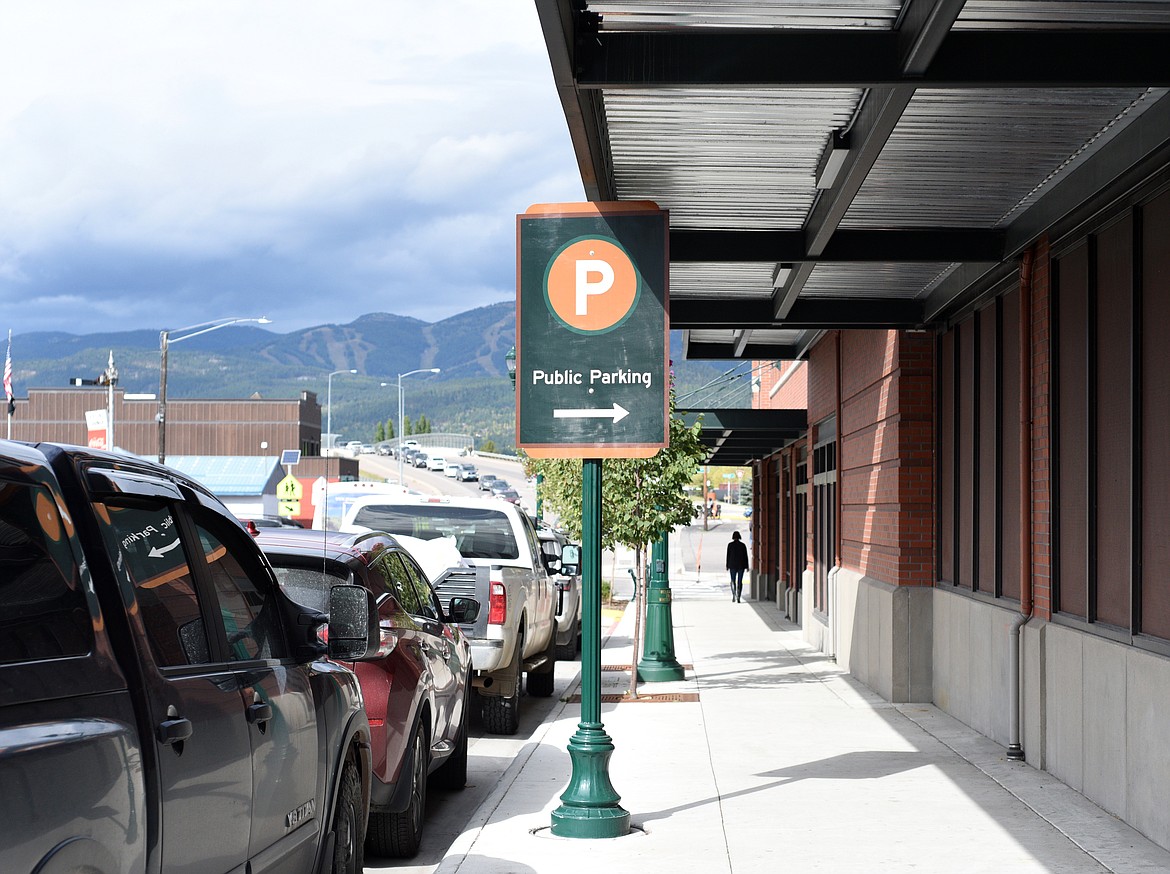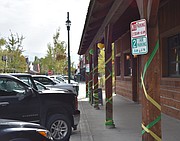Plan recommends city manage parking spaces before adding more
A draft parking management plan says that while parking in downtown Whitefish can be challenging especially during the summer months and events, the situation could largely be improved through better management of parking already available rather than adding new spaces.
The parking plan created by Dixon Resources Unlimited says the “root issues related to parking in downtown Whitefish are largely related to lack of parking management.” It says that Whitefish currently has a supply of spaces that are not chosen by parkers because of location, lack of signage or because regulations that don’t enable balanced use of the parking spaces.
Dixon Resources Unlimited, which provides parking consulting services to municipalities, was contracted by the City of Whitefish to create a parking management plan for the downtown area. The draft plan was recently presented during a work session to City Council, which is set to hold a public hearing on Oct. 21 before considering adoption of the plan.
The parking consultants created the plan following a series of meetings with citizens, business owners and city staff during this summer, in addition to reviewing previous Whitefish parking studies.
Kenzie Coulson, with Dixon Resources, says the parking management plan has some immediate priorities that it sets out, but the plan is designed to be considered as a whole with long-term strategies too. She said the plan addresses some key findings for parking in Whitefish and implementing just one item in the plan may not prove effective.
“We found that there are localized shortages in parking and heavy area of demand on select streets,” she said. “The goal is to dissipate that high demand on Central Avenue, for example, and encourage parking on under-utilized streets and in the parking garage as well.”
Parking occupancy data collected by the city in 2018 showed that the average occupancy per each time of day ranged from 37% to 63%, the study says, meaning that there are streets often reaching occupancy during select times and there are streets that show a routinely low level of use. The parking industry standard for ideal parking occupancy is between 80% to 85% to maintain availability and reduce congestion associated with drivers seeking parking, however, Dixon Resources notes that it may be more useful to target an occupancy range of 65% to 85% to account for seasonal demand.
The data shows that parking strategies can “dissipate parking demand on select streets and increase demand on other streets that are currently underutilized.”
Julie Dixon, principal with Dixon Resources, said Whitefish doesn’t necessarily need more parking, but folks just don’t understand how easy it is to walk to destinations in downtown and adjustments should be made for when parking time limits are in place.
“We have to manage the inventory that you have today,” she said. “While making sure that from a walkablity standpoint there is ample parking, but there’s also an opportunity to educate and inform so we can rebrand the parking experience in Whitefish.”
Representatives from business organizations seem to agree with Dixon Resources’ assessment of the parking challenges in Whitefish.
Rhonda Fitzgerald, with the Heart of Whitefish, said for most of the year Whitefish has enough parking spaces and people get in the habit of parking close to their destination.
“In the summer there isn’t parking so we do have a very seasonal problem that we need to solve,” she said. “Evenings are busier than mornings, I don’t think there’s much difference between a Wednesday or Saturday for parking.”
Kevin Gartland, executive director of the Whitefish Chamber of Commerce, agreed.
“What we’re really looking at is an eight to 10-week crunch for parking in the summer,” he said. “When folks come to town and ask me should I come back tomorrow during that time period it doesn’t really matter.”
The parking management plan suggests a few key recommendations as part of the larger 66-page comprehensive plan to improve parking, including adding a seasonal parking enforcement officer, technology upgrades related to parking, creating shuttles for targeted peak times, and develop an “all-day” parking permit focusing on downtown employees.
The plan recommends improving parking operations in compliance and enforcement, along with management and community outreach regarding parking.
It recommends adding a seasonal parking enforcement officer for the summer months to increase enforcement including on weekends and evenings. In 2018, the city issued 1,956 parking citations. About 15 to 25 were given per day in the peak summer season, while the remainder of the year on average about four citations were issued per day.
The plan also recommends that the city implement an ambassador approach to parking, by having enforcement personnel use a customer-focused approach to monitor parking, but also provide education on where best to park and how to access different areas of downtown.
“Training and standard procedures should focus on education and a customer service-based approach,” Coulson said.
The study also recommends that the city extend the hours for time limits on parking spaces to seven days per week from 8 a.m. to 8 p.m. to increase the turnover and availability in time-limit spaces. It notes that there is high demand for parking after 6 p.m. and on weekends, and this would create consistent expectations for those parking, while creating parking turnover near retail and restaurant establishments during the hours customers are visiting those establishments.
The plan notes that there is demonstrated demand for increased “all-day” employee parking options and a lack of long-term parking spaces create a situation where employees are moving their vehicles among short time-limit restricted spaces. This adversely effects those seeking short time-limit spaces such as for retail shopping, the plan notes.
Coulson said employee parking was a No. 1 concern cited during the stakeholder meetings held prior to creating the plan.
“There are many who are seeking longer, all-day parking options in your downtown core,” Coulson said. “They are currently parking in two-hour spaces designed for short-term visits to businesses.”
The plan recommends creating “all-day” parking permit for downtown employees at several locations throughout the downtown core. Coulson said the locations have to be scattered throughout downtown because employees have said they’re not interested in walking long distances to park.
Right now, because on-street parking is free and those parking believe they won’t be ticketed, that is little reason for drivers to use a paid permit program, but the plan says once enforcement is increased then drivers will seek options for all-day parking.
Working with community and business leaders to determine the cost for the all-day parking permits is key to that they are utilized and employees will be able to afford them, the plan notes. It points out that the city currently offers leased parking in the garage attached to City Hall and that the uncovered parking spaces at $30 per month have availability.
Dixon said while the cost of the leased spaces to some doesn’t seem to be much, for those who are working minimum wage jobs the cost can price them out of using them.
“The cost of the permit can’t be a prohibiting factor,” Dixon said. “There also needs to be buy-in from restaurant and retail owners as to the importance as to why the parking spaces need to be open to customers,” she said.
Councilor Richard Hildner pointed to an parking lot near the U.S. Post Office building on Baker Avenue that he says almost always has available spaces, and getting employees to walk to work from all-day parking lots could be difficult.
“That’s a three-minute walk to City Hall,” he said. “One of the things that is missing is, how do we encourage people to get out of their cars and walk four blocks.”
Dixon said one of the components of parking management is education, along with creating incentives to get people to park and walk to their destination, which does include enforcement of parking regulations.
“This is about parking management as a whole,” she said. “This is about years and years of practice — change doesn’t happen over night.”
Councilor Melissa Hartman said while she likes the idea of all-day employee parking spaces, she also wondered if that would take away from some of the spaces close to shopping.
Dixon says creating some all-day spaces for visitors might be necessary also for those looking to stay in downtown all day.
Additionally, the plan recommends developing alternative modes of transportation such as biking and walking, but specifically creating a shuttle service to use during specific events. The shuttle system would use park and ride lots located outside of the core downtown targeted to the peak summer season for periods including events such as the Fourth of July or Whitefish Farmers Market.
“The idea is to pilot this during specific events,” Coulson said. “We see this as an opportunity to continue to reduce congestion at very targeted times.”
The parking plan says that while past studies show a pointed interest in constructing parking garage facilities, other steps should be taken first to manage current parking spaces, and to build a garage without addressing current management issues would be costly and result in continued underutilization of parking.
“This is about managing your existing supply and I think in doing so you’ll find that perception of demand is going to change,” Coulson said. “By simply building an expensive garage what you would likely find is you still have a parking issue.”
The consultants point out that the current parking garage attached to City Hall is currently underutilized noting that even during peak times it is only about 70% to 80% full. This is caused, in part, because of a lack of wayfinding signs to help drivers locate the garage, and signs in the garage can often be confusing. The plan also suggests the city consider adding a digital system that could transmit information to digital signs inside or near the garage that would allow divers to see the availability of parking before driving into the garage.
The draft downtown parking plan is available on th city’s website at www.cityofwhitefish.org under the Planning and Zoning page by clicking on Long Range Plans.



